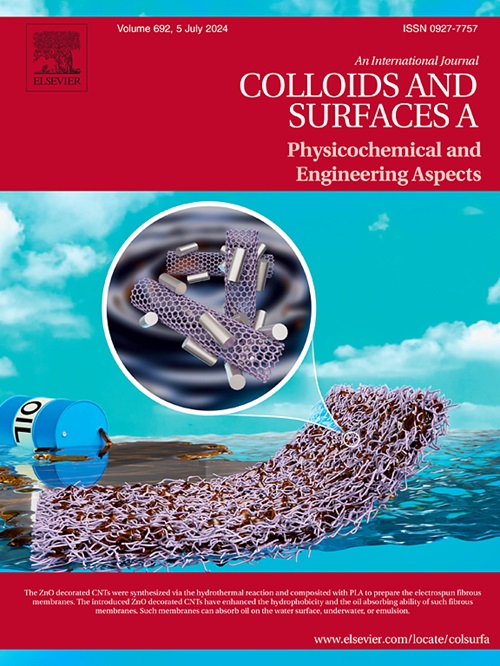Fabrication of a PVDF composite membrane with potential of self-cleaning property for efficient emulsion separation and dye degradation
IF 4.9
2区 化学
Q2 CHEMISTRY, PHYSICAL
Colloids and Surfaces A: Physicochemical and Engineering Aspects
Pub Date : 2025-07-03
DOI:10.1016/j.colsurfa.2025.137664
引用次数: 0
Abstract
Endowing the membrane with self-cleaning properties effectively mitigates surface fouling caused by pollutants during the operation of separation membranes. In this study, PVDF composite membranes (M/BM) containing Bi2MoO6-OVs and polyethylene-maleic anhydride copolymers (PEMA) were fabricated via non-solvent-induced phase separation (NIPS). Subsequently, the membranes underwent acid and alkali treatments to enrich their surfaces with a large number of carboxyl groups. Finally, β-FeOOH micro-nano particles were in-situ grown on the membrane surface, resulting in the successful fabrication of a self-cleaning PVDF composite membrane (M/BM/β-FeOOH). The composite membranes has high separation efficiency and high flux for different oil-water emulsions, and it can completely degrade methylene blue, rhodamine B and methyl orange in a short time, and achieves a high degradation efficiency (>99 %) after 10 cycles. After 5 cycles of oil-water separation followed by Fenton cleaning, the membrane's separation efficiency remains above 99 %. This research provides a new method for developing separation membranes for oily wastewater.
具有自洁性能的聚偏氟乙烯复合膜的制备,用于乳液分离和染料降解
使膜具有自洁性能,有效减轻分离膜运行过程中污染物对表面的污染。采用非溶剂诱导相分离(NIPS)法制备了含Bi2MoO6-OVs和聚乙烯-马来酐共聚物(PEMA)的PVDF复合膜(M/BM)。随后,对膜进行酸和碱处理,使其表面含有大量羧基。最后,在膜表面原位生长了β-FeOOH微纳粒子,成功制备了自清洁PVDF复合膜(M/BM/β-FeOOH)。复合膜对不同油水乳状液具有高分离效率和高通量,可在短时间内完全降解亚甲基蓝、罗丹明B和甲基橙,循环10次后降解效率较高(>99 %)。经过5次油水分离,再进行Fenton清洗,膜的分离效率保持在99%以上 %。本研究为含油废水分离膜的研制提供了一种新的方法。
本文章由计算机程序翻译,如有差异,请以英文原文为准。
求助全文
约1分钟内获得全文
求助全文
来源期刊
CiteScore
8.70
自引率
9.60%
发文量
2421
审稿时长
56 days
期刊介绍:
Colloids and Surfaces A: Physicochemical and Engineering Aspects is an international journal devoted to the science underlying applications of colloids and interfacial phenomena.
The journal aims at publishing high quality research papers featuring new materials or new insights into the role of colloid and interface science in (for example) food, energy, minerals processing, pharmaceuticals or the environment.

 求助内容:
求助内容: 应助结果提醒方式:
应助结果提醒方式:


